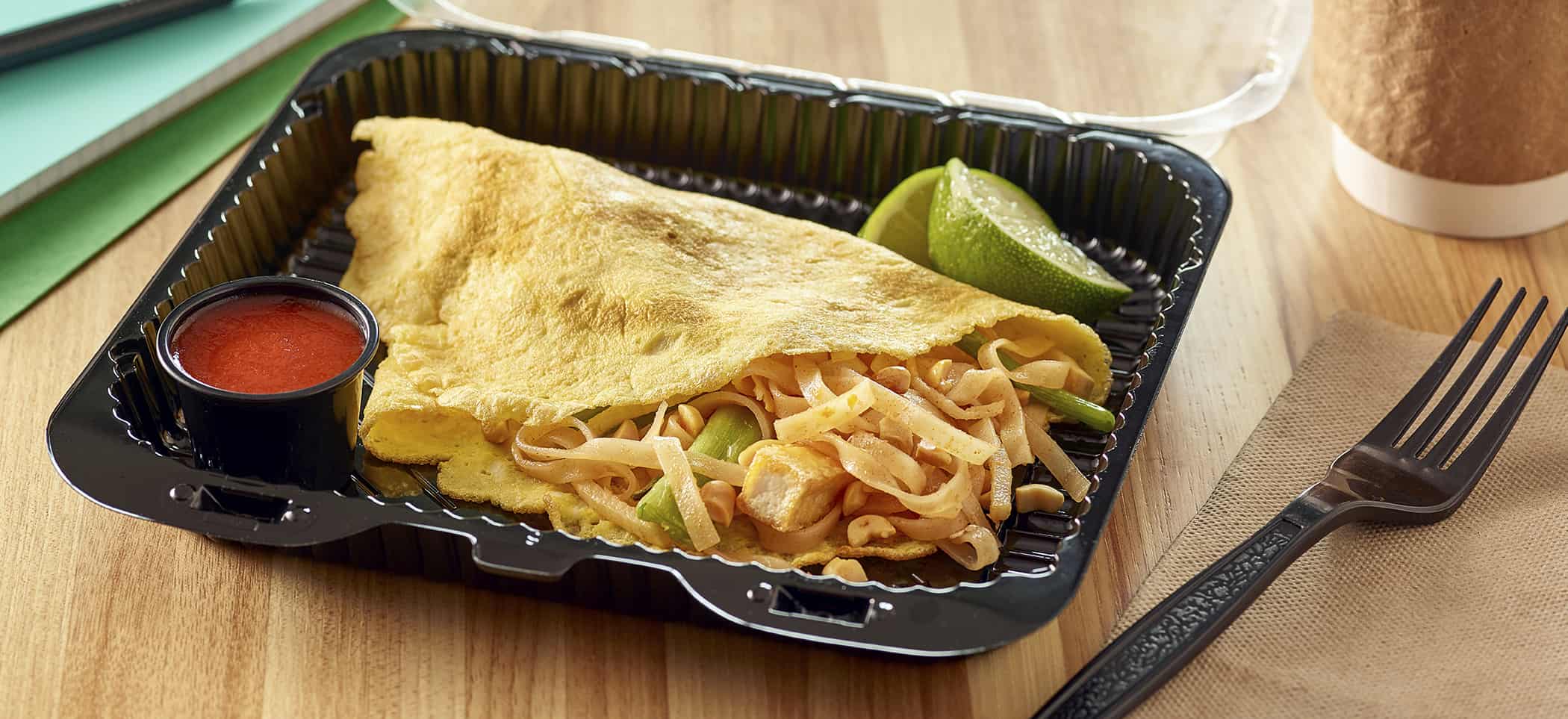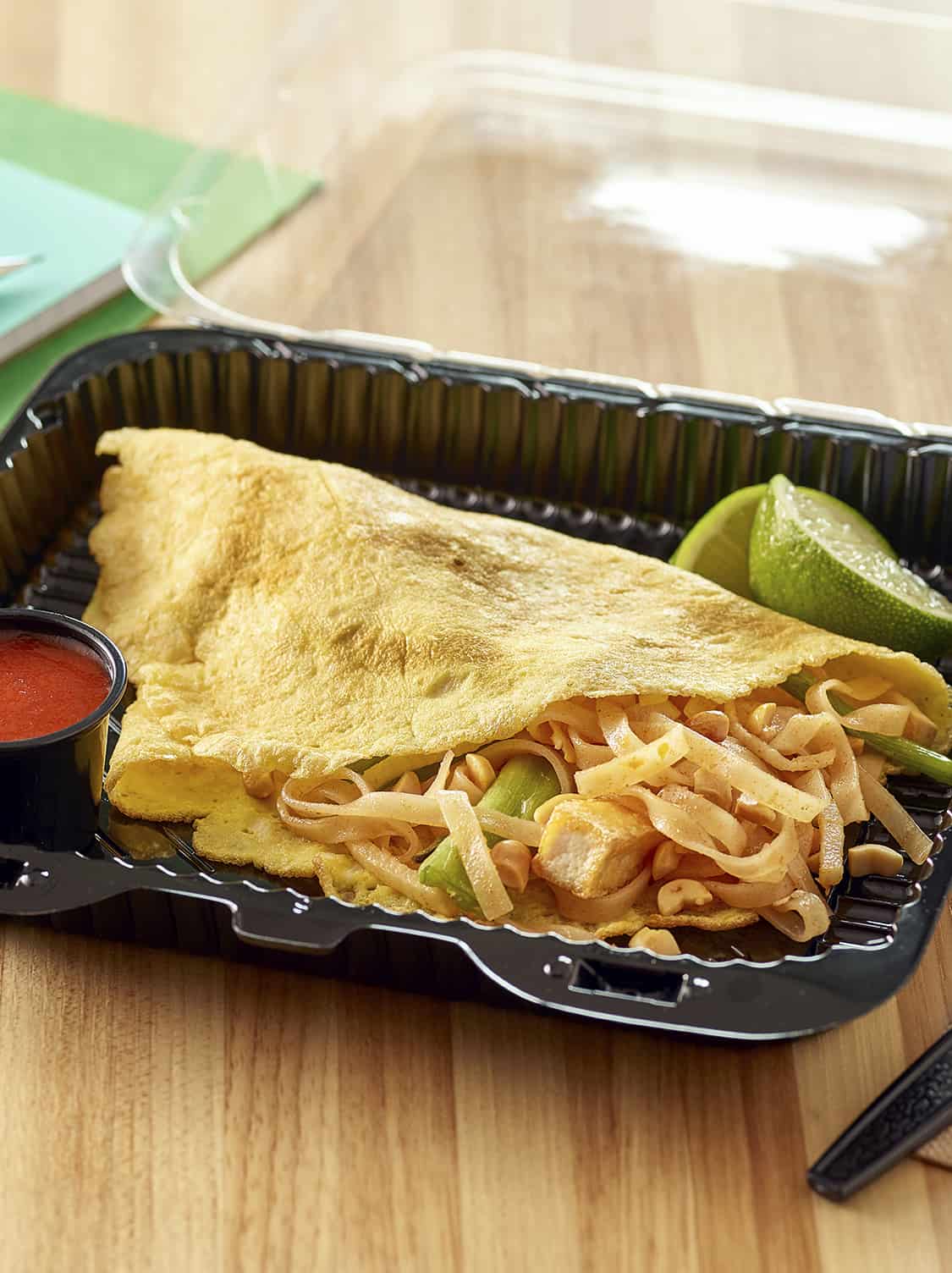

Eggs are commonly found inside Pad Thai noodles, yet this version where the egg is made into a thin omelet to wrap up the noodles themselves is something found only occasionally in Thailand. Perfect for a grab-n-go container since the eggs keep all those sweet-salty and umami-rich noodles moist inside where the customer can quickly microwave them in a couple of minutes for a virtual journey to the streets of Bangkok
Yield: 10 portions
Ingredients and Directions
- Pad Thai Sauce Base
Directions
Heat oil in saucepan over medium heat. Fry shallots and garlic until garlic begins to turn golden.
Add water, fish sauce, tamarind, sugar, peanuts, chilies and salt. Bring to a boil, simmer 1 minute. Remove from heat.
Sauce can be made, cooled and stored in the refrigerator for up to a week.
Ingredients
- ¼ cup vegetable oil
- ½ cup minced shallots (1 oz. / 28 gm)
- 3 Tbsp. coarsely minced garlic (1 oz. / 28 gm)
- 1 cup water (6 oz. / 180 gm)
- ½ cup fish sauce (4 oz. / 120 ml)
- 3 oz. prepared tamarind pulp (2 oz. / 60 ml)
- ½ cup light brown sugar (3 oz. / 82 gm)
- ½ cup finely chopped roasted peanuts (2 oz. / 56 gm)
- 1 - 2 tsp. ground red chilies or red pepper flakes
- ¼ tsp. salt
- Noodle Stir-fry
Directions
Prepare noodles and cool: Soak noodles in room temperature water for 30 minutes, drain well. (They will only be partially hydrated.)
In large sauté pan (or if recipe is multiplied in rondo or tilt skillet), heat oil until hot. Add rice noodles and tofu, stir vigorously coating noodles with oil somewhat evenly. Then add sauce, continue to stir-fry until sauce is absorbed by noodles. Taste and check for texture of noodles and seasoning.
Continue to stir-fry adding extra water as needed to hydrate noodles. If flavor is out of balance, use fish sauce, tamarind, sugar and/or salt to adjust. Season aggressively, as you will still fold in 4 cups vegetables.
When they are almost ready, fold in bean sprouts/jicama,chives/onions and peanuts. Taste and adjust seasoning one last time. Cook until onions are wilted, and bean sprouts are cooked through. The noodles should be a little chewy, moist and not saucy.
Ingredients
- ¼ cup vegetable oil
- 1 lb. dried flat Pad Thai rice noodles (about ¼-inch wide)
- water as needed
- 1 lb. extra-firm pressed bean curd/tofu (cut into about ¼ x ¼ x 2-inch strips)
- 4 cups bean sprouts (substitute with julienned jicama)
- 1½ cups chinese “garlic” chives (substitute green only of green onions/scallions)
- ½ cup coarsely chopped roasted peanuts
- Service & Assembly
Directions
Made in the back kitchen or at an action station in front of the guests, these thin egg sheets take seconds to cook and fill with the precooked hot noodles.
Beat eggs until smooth.
Preheat nonstick griddle to 450° F; coat generously with oil.
Ladle 2 oz. eggs on to griddle and allow/guide with spatula into a “random oval”
Allow eggs to set up slightly, then deposit one portion of the precooked Pad Thai noodles on top.
Using large spatula fold eggs over, roll up to wrap noodles with egg sheet. It’s actually desirable to have some of the noodles coming out of egg wrap edges.
Transfer to to-go container.
Garnish with lime wedge.
Ingredients
- vegetable oil, as needed
- 15 large eggs
- 1 sub-recipe cooked and hot Pad Thai noodles
- 10 lime wedges
To ensure food safety, eggs should be cooked until both the yolk and the white are firm. Consuming raw or undercooked eggs may increase your risk of foodborne illness, especially for those with certain medical conditions. For recipes that call for eggs that are raw or undercooked when the dish is served, use either pasteurized shell eggs that have been treated to destroy Salmonella, or use pasteurized egg products.
